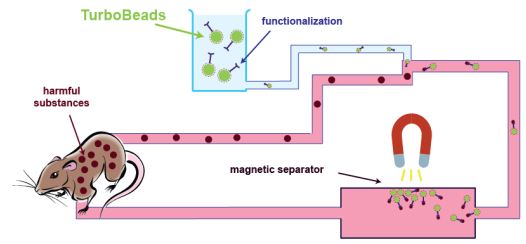
Ionic Liquid Helps Recycle Rare Earth Elements
December 31, 2013
 Rare-earth magnets are indispensable components in computer hard drives, wind turbines, audio speakers, and electric vehicles. Because of the insecure supply chain and price fluctuations of rare-earth metals, scientists are interested in developing efficient, safe, and environmentally friendly methods for recycling magnets to recover the metals.
Rare-earth magnets are indispensable components in computer hard drives, wind turbines, audio speakers, and electric vehicles. Because of the insecure supply chain and price fluctuations of rare-earth metals, scientists are interested in developing efficient, safe, and environmentally friendly methods for recycling magnets to recover the metals.
Tom Vander Hoogerstraete, Koen Binnemans, and coworkers at the University of Leuven, in Belgium, have come up with such a method, one that relies on extracting the metals with an ionic liquid ( Green Chem., DOI: 10.1039/c3gc40198g ). A common way to separate metal ions is by liquid-liquid extraction of acidic aqueous solutions of dissolved metal ions with an organic solvent containing an extraction agent. Rather than using a volatile, flammable solvent as is customary, the Leuven researchers tried ionic liquids, which are nonvolatile, nonflammable organic-based salts with low melting points. By using a tetraalkylphosphonium chloride ionic liquid, which functions as both a solvent and extraction agent, the researchers separated cobalt from samarium and iron from neodymium with better than 99.98% efficiency. They focused on those metal combinations because samariumcobalt and neodymium-iron-boron magnets are two of the most common types of rareearth magnets. After the extractions, the researchers stripped the cobalt and iron out of the ionic liquid so they could reuse it.
Measuring Magnetic Nanoforces Under the Microscope
December 15, 2013
NanoScan specializes in the measurement of magnetic properties of materials at the nanoscale, using scanning probe microscopy. The Swiss company aims to achieve the best magnetic lateral resolution in direct space, with minimal time for measurement. To achieve this, its team of physicists, electrical engineers and software engineers develops the
company’s microscopes, from the mechanical parts to the electronics controller and the software, with the desire to provide high-resolution scanning probe microscopes that fulfill present and future analytical needs on nanometer-sized
surface structures.
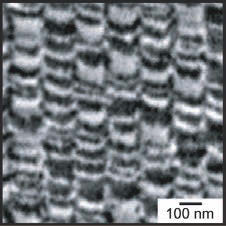 Dr Raphaëlle Dianoux, NanoScan’s CEO, says: “Our aim was to establish a niche application, and that was magnetic force microscopy. Designed for research, development and quality control of magnetic storage media and other magnetic material, our product, the hr-MFM (high-resolution magnetic force microscope), is an analytical and quantitative magnetic imaging system.” For an imaging example, see the magnetic force microscopy image to the right of a commercial hard disk, taken with the hr-MFM. The single bits are clearly recongnizable as bright (dark) patterns magnetized in the direction opposite (parallel) to the tip magnetization. The high resolution of the microsccope reveals the slightly curved and even grainy substructure of the bits.
Dr Raphaëlle Dianoux, NanoScan’s CEO, says: “Our aim was to establish a niche application, and that was magnetic force microscopy. Designed for research, development and quality control of magnetic storage media and other magnetic material, our product, the hr-MFM (high-resolution magnetic force microscope), is an analytical and quantitative magnetic imaging system.” For an imaging example, see the magnetic force microscopy image to the right of a commercial hard disk, taken with the hr-MFM. The single bits are clearly recongnizable as bright (dark) patterns magnetized in the direction opposite (parallel) to the tip magnetization. The high resolution of the microsccope reveals the slightly curved and even grainy substructure of the bits.
The article about NanoScan was published in the Journal "Magnetic Technology International 2013". For even more articles, check out http://ukipme.com/pub-magnetics.php.
Synthesis of Anisotropic 3D Magnetic Microspheres
December 14, 2013Navid Hakimi and others in Dae Kun Hwang's research group at Ryerson University, Toronto, Canada are masters of making strangely shaped three-dimensional anisotropic microparticles using a simple one-step microfluidic based method.
The method exploits the non-uniformity of the polymerizing UV light, UV absorption by opaque nanoparticles in the precursor solution, and discontinuous photomask patterns to make magnetic and non-magnetic microparticles in a two-dimensional microchannel. Numerical simulations of monomer conversion in the microfluidic channel are performed to predict the manufactured particle shape.
For more details, check out the article here: DOI: 10.1002/adma.201304378.
Magnetic Particle Workshop (IWMPI) 2013
November 29, 2013
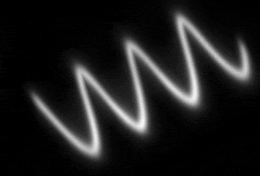 The 3rd International Workshop on Magnetic Particle Imaging (IWMPI) was held in Berkeley, CA USA on March 23-24, 2013. This year, there were a total of 70 presentations (44 oral and 26 poster presentations), and 4 keynote speeches. Please see the Workshop Program for details.
The 3rd International Workshop on Magnetic Particle Imaging (IWMPI) was held in Berkeley, CA USA on March 23-24, 2013. This year, there were a total of 70 presentations (44 oral and 26 poster presentations), and 4 keynote speeches. Please see the Workshop Program for details.
The proceedings are now available online at IEEEXplore.
For those who were not able to attend the workshop, there are the videos of keynote speeches available online. Check it out here: http://iwmpi.berkeley.edu.
And then don't forget, the next meeting will come soon, in Berlin in March 2014!
Nanotherapeutic Shows Promise in Eliminating Lethal Tumors
November 27, 2013
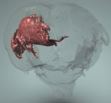
Although these "spherical nucleic acids" are not magnetic, maybe we can do the same thing with very small magnetic nanoparticles. Try!
Nanomagnet-Based Removal of Digoxin and Lead from Living Rats
November 22, 2013Inge Herrmann et al. reported the in vivo (rat) purification of blood from Pb and digoxin. For this TurboBeads were functionalized with an iminodiacetic acid-based chelator respectively a digoxin antibody FAB (digiFAB). In detail, the nanoparticles were injected into an extracorporeal purification process. The functionalized magnetic beads bound the harmful substances and the actual seperation took place with the help of an applied magnetic field. A 50 % drop of concentration of both lead and digoxin could be achieved as fast as 10 minutes.
Get the details here: Nanoscale 2013, 5, 8718. (DOI)
The same group also reported the in vitro purification of blood from endotoxins via polymyxin B-functioanlized highly magnetic TurboBeads. The nanoparticles were added to endotoxin spiked blood and were thereafter magnetically separated from the solution. The efficient removal of endotoxins from blood by this straight forward procedure was investigated by ELISA.
Special Issue about Magnetic Nanoparticle Hyperthermia
November 13, 2013
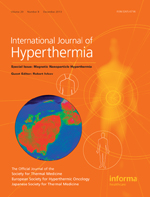 In 1957 an American surgeon, Robert Gilchrist ignited excitement by suggesting the possibility that cancer can be treated with magnetic nanoparticle hyperthermia. Magnetic nanoparticles provide unique capabilities for biomedical research and clinical applications, some of which have been realized within the past two or three years. Much greater potential exists, but challenges must be addressed.
In 1957 an American surgeon, Robert Gilchrist ignited excitement by suggesting the possibility that cancer can be treated with magnetic nanoparticle hyperthermia. Magnetic nanoparticles provide unique capabilities for biomedical research and clinical applications, some of which have been realized within the past two or three years. Much greater potential exists, but challenges must be addressed.
A just published special issue of the International Journal of Hyperthermia brings together original research and review articles from leaders in the field whose contributions highlight recent progress and future directions for cancer research and therapy with magnetic iron oxide nanoparticles. Dr. Robert Ivkov did a great job at editing this issue (Volume 29, Number 8, December 2013).
Check out all the different articles here:
http://informahealthcare.com.ezproxy.library.ubc.ca/toc/hth/29/8
Catalytic Nickel and Cobalt Nanowires
November 04, 2013
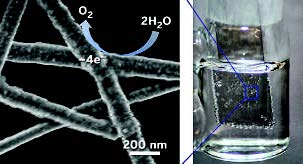 If we could convert sun power to hydrogen in an inexpensive and sustainable way, we would have an environmentally friendly fuel - forever! Steps are now taken towards this goal at Duke University by chemists Zuofeng Chen, Benjamin J. Wiley , and coworkers have. In one potentially low-cost method, sunlight enters a specially designed cell and triggers a multistep electrochemical process that begins with water oxidation on a catalyst surface. That reaction produces O2 and frees electrons and protons, which can be combined to yield H2 .
If we could convert sun power to hydrogen in an inexpensive and sustainable way, we would have an environmentally friendly fuel - forever! Steps are now taken towards this goal at Duke University by chemists Zuofeng Chen, Benjamin J. Wiley , and coworkers have. In one potentially low-cost method, sunlight enters a specially designed cell and triggers a multistep electrochemical process that begins with water oxidation on a catalyst surface. That reaction produces O2 and frees electrons and protons, which can be combined to yield H2 .
These photoelectrochemical cells often depend on indium tin oxide (ITO), a transparent, electrically conductive material, coated with a catalytic metal oxide. Because of its ability to serve as a transparent electrode, ITO is the go-to material for various photoelectrochemical processes. But indium and ITO are expensive. In addition, the catalytic oxide layer reduces ITO’s light transmission and thus cell efficiency, and its conductivity falls with extended use. The Duke team developed copper nanowires coated with a shell of nickel or cobalt as successful replacement. Initial tests show that a mesh of this inexpensive, transparent, conductive material exhibits sustained water oxidation activity comparable to that of metal oxide films, but transmits nearly seven times more light. In addition, the material can be deposited on glass or plastic substrates via simple liquid-phase methods, which may lead to new types of robust, flexible photoelectrochemical cells and other devices. Check out the original paper here.
For more information, check out our Archives.
September 2017

Search this site with the power of


